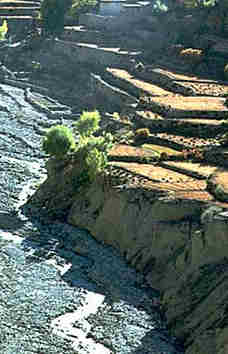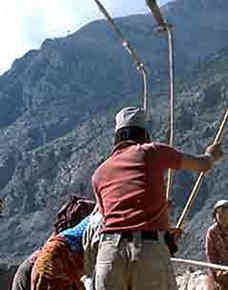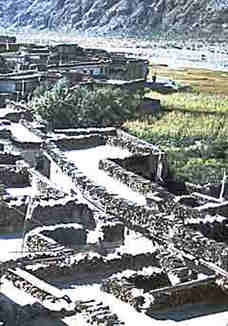METROPOLIS TO MATRIPOLIS
Sketching a vision of empowerment through solar
energy
by David Dobereiner, Architect
What goes for pyramids goes for other solids, as we shall see — and mountains. This principle of adding volume and illuminated surface area to a flat site without loss of sunlight absorption is easily demonstrated with a sheet of paper. Lay a piece of typing paper on a table. It will occupy 93.5 square inches of table surface. Screw it up, partially stretch it out, and lay it on the table again. Now measure it on plan. It measures, say, 7" X 6". At 42 square inches it is now occupying less than half of the area occupied by a flat sheet. But its surface is only crinkled, not changed in area. You have created a volume with an illuminated surface greater in area than the area of its base.
In Asia you can see mountain slopes invariably terraced for farming on all slopes that are not too steep, rocky or icebound. Nothing is wasted. The forested areas left on the upper slopes and in the steep gullies are a necessary part of the system since these trees with their deep root systems stabilize the topsoil (Figure 1). All the fields get whatever sunlight is available for at least part of the day. The fields are flattened only to the degree necessary to make cultivation possible. To go further would be counterproductive since it would take up much more labor time in earth moving, more rocks and labor building higher retaining walls and would reduce the area of the field and therefore, the yield (Figure 2).
The farmers live in compact village settlements close to the fields but invariably on the steeper slopes, leaving the prime land for the growing of food. They build their houses of the same materials as the terraced fields; earth and rock. In many cultures, such as these Tibetan ones, the houses have flat roofs so that they appear as inhabited parts of a continuous homogenous landscape (Figures 3,4,5,6 and 7). Indeed the roofs are also used for agricultural purposes such as threshing or drying peppers (Figure 8). For centuries these villagers lived in a stable equilibrium with their environment. They had strong communal structures that protected and maintained the elaborate and vital irrigation channels and prevented the erosion of the forest slopes above, from which wood was gleaned for their only energy source, the mud-built kitchen stove.
When the central government took over, these communal structures were fatally weakened. As a result the surrounding slopes quickly became shorn of all their vegetation. Mud slides became common and people found it had become necessary to take horses on a two day trek to find firewood.
In my capacity as an architect I was contracted by UNICEF to carry out environmental improvements in some of these villages. I developed an inexpensive polyethylene solar water heater they could install on their flat roofs and made a prototype solar oven out of the ubiquitous biscuit tins which are one of the few manufactured objects found in the area. I also built a demonstration solar heated school and a passive solar hotel. These experiments at least showed that there were ecologically sound solutions to some of their problems. In the long term, though, they need an enlightened government that will restore autonomy to their traditional communal institutions, combined with the kind of educational and technical support that is generous and above all, relevant.
These examples of the present day problems of a mediaeval society may not seem relevant to industrialized urban society entering a new millennium, but I submit that they are relevant, for the following reasons:
- 'Agribusiness', more than any other sector of industry, is in urgent need of reform mainly because it is bringing about the depletion of irreplaceable topsoil. Part of the remedy consists of growing the food closer to those who consume it. This means a large increase in urban agriculture, horticulture, hydroponics, permaculture and food gathering, mainly on roof terraces.
- Industry needs large scale conversion from fossil fuels to
solar and other clean power sources. Prototypical development
at village scale precedes application at urban and global scales.
In both cases current practice uses polluting hydrocarbon based
fuels. In both the practice is unsustainable and undesirable anyway.
So much for the physics of urban ecology. Now for the metaphysics.
In addition to the radical technological reform that is needed there is a corresponding change in 'mind set' required. The human species cannot go on acting as if the universe was created for its sole benefit by a humanoid Deity who made us in His image, and sanctions us to trash and burn everything we think stands in our way. The Enlightenment gave birth to the scientific revolution that made possible our industrial civilization. But Europe, which cradled this development, carried the baggage of a powerful religious mythology that was in fundamental conflict with it. This only really becomes clear today when we have seen scientific inquiry lead to an understanding of the unity of all life in the biosphere, the cutting edge of science we now call Ecology.
Whatever our belief is regarding the existence or non-existence of an original Creator, there is a fundamental difference between believing that the human species is essentially of a different order and origin than the other species and believing, as most of us do today that we evolved. It is the first belief that has led us to our present impasse, and, the second belief that needs to prevail if we are to survive, since, without it, we will never achieve the degree of respect due to our evolutionary ancestors that is prerequisite to our re-entry into their world as fellow creatures of an ancient earth culture. Without that kind of re-awakening we will continue to destroy habitats and drive to extinction life forms that are 98% as complex, miraculous, and rare, as we are (Figures 9 and 10). The truth is, it is only that one remaining chance genetic mutation that lead to one primate developing language. The rest is history, literally.


